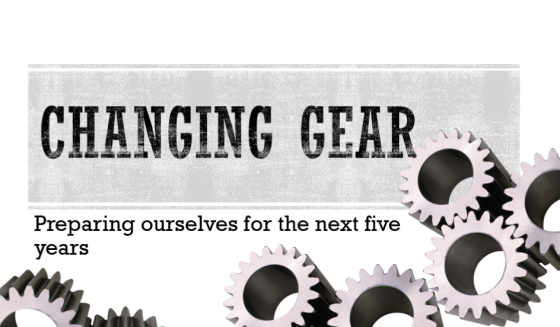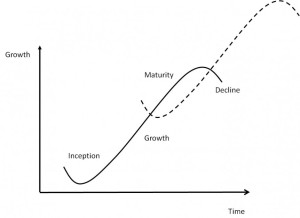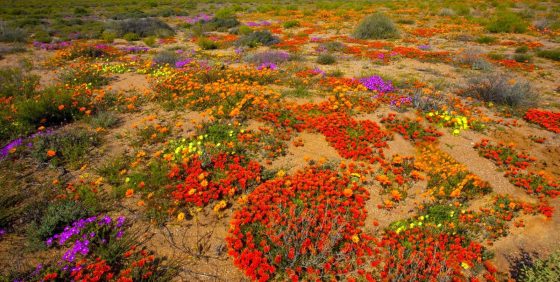 We met as a whole staff and governor team this morning – or at least as many as were able. 63 of us gathered to look at the school vision and to assess where we could take responsibility for, and pride in, its success. The full presentation can be downloaded by clicking on the image above, but I reproduce below some of the ways in which we encouraged each other to see how much progress we had made toward the vision of the school since we wrote it in 2012. There has been a strong feeling around the leadership team of late that to enable all of us as adults in the school community to back the vision, we need to see how much we already have, individually and corporately, contributed to it.
We met as a whole staff and governor team this morning – or at least as many as were able. 63 of us gathered to look at the school vision and to assess where we could take responsibility for, and pride in, its success. The full presentation can be downloaded by clicking on the image above, but I reproduce below some of the ways in which we encouraged each other to see how much progress we had made toward the vision of the school since we wrote it in 2012. There has been a strong feeling around the leadership team of late that to enable all of us as adults in the school community to back the vision, we need to see how much we already have, individually and corporately, contributed to it.
To help people define the contribution that they have made, I asked each of them, personally, to identify 3-4 actions where they had definitively impacted on the success of some aspect of the vision. Examples to help them were given to help them define their thinking further:
The Good Earth…At Christ the Sower Ecumenical Primary School, we provide the GOOD EARTH for all in our community to flourish: where every member can be who they were created to be, with the high expectation that we, individually and collectively, will bear fruit beyond our wildest dreams – a place where we are LOVING, LEARNING, GROWING together.
- …we treat individuals with the care that God intends for them
- …we refuse to let anyone think less of themselves than they ought
- …we plan great lessons that meet the needs of all of our children
- …we adapt our work and our planning to meet the needs of those we work with
- …we write and implement policies that protect the vulnerable
- …we insist that learning together is as important as learning individually
- …we model respectful and kind relationships for the children and for parents and for each other
- …we show by “going the extra mile” that what we do is more than just a job
- …we make space for each other and for children to dream and imagine a wonderful future
A loving community…At our heart is an ever-increasing understanding of God as a source of love. Because we know each child as a UNIQUE TREASURE, we value each other, treating each other as we would expect to be treated ourselves. Being motivated by love, we strive to be a community where everyone works for the good of everyone else.
- …we have a conversation with a child that is not just about their learning
- …we notice, and do something about it, when a colleague is looking poorly
- …we use restorative practice to sort out a broken relationship
- …we plan for each child to learn what they need
- …we teach children to respect and love their friends and family
- …we use What-If learning to enable children to see life from others’ point of view
- …we teach children to think about how they would want to be treated in any situation they face
- …we submit to one another’s wishes for the good of the friendship, and teach children to do the same
- …we speak politely to those who disagree with us or who choose to be rude to us
A learning community…Believing that we can all excel, we are a community that deeply desires to learn. We nurture children and adults so that we are all empowered to be fearless, lifelong learners: embracing challenge, releasing creativity, persisting through difficulty, seeing mistakes as opportunity, discovering for ourselves and responding in wonder to what we find.
- …we judge the quality of our teaching by what our children have learnt
- …we notice children’s good learning and build on that
- …we help children over obstacles to their own learning
- …we help children find creative ways of expressing their learning
- …we identify ourselves as learners and pay attention to our own learning and qualification
- …we choose to learn from our own mistakes and help children (and other adults) learn from theirs
- …we pay attention to our agreed theory of learning to help children’s learning go deeper
- …we allow children space to wonder and be amazed at the world, and treasure that wondering
- …we refrain from giving the answers too early and allow children to discover answers for themselves
- …we plan lessons which are open-ended; or plan child-owned units of work
A growing community…We diligently strive for excellence in all we do by working our hardest and seeking to improve. At Christ the Sower we “grow” people who are able to embrace the fullness of life and nourish a growing community where that life can be expressed.
- …we create opportunities in our classroom for children to serve each other
- …we give children “work-roles” in our school
- …we, at any time, value children as members of their families
- …we celebrate what is special to children
- …we do not accept second-best, either for ourselves or for our children
- …we speak of good work as valuable and worthy of our best efforts
- …we take time to listen to children’s concerns, wherever we are in school
- …we take care with the school’s resources and use them well and with respect
- …we plan as leaders for the best use and deployment of staff
- …we choose to pay the Living Wage, not the minimum wage
- …we seek opportunities to be involved in school life even beyond our “remit”
A community together…We rejoice in our diversity and recognise that we are parts of the same body journeying together, walking hand-in-hand with God. We aim to provide a rich and true experience of Christian community, being a beacon of love, light and hope here on the west flank of MK.
- …we welcome parents into classrooms as partners in learning
- …we offer hospitality to visitors, to governors, to new children and their families
- …we alter our perspective to allow others’ points of view to influence us, and accept and celebrate those
- …when we act deliberately out of God’s love for us and consciously act as disciples
- …we speak well of each other, and allow hope for the future to determine our actions
- …we combine realism with compassion in how we treat each other.
Obviously, staff had freedom to choose beyond these suggestions, but one of the best features was the way that members of teams spurred one another on to recognise the work that they had done, so finding ways of showing affection, deepening learning, building community – all of these could often be seen more clearly by those working alongside a person than they could by the person themselves. And many people said that they had not heard colleagues talk about our school vision in such a focused way before. The whole morning was thoroughly positive, affirming and richly encouraging. The very best thing was when each person took the card where they had identified their specific contribution, worked on within the context of the team they knew best, and then shared their contribution in groups designed to contain groups from all sorts of school constituencies. Interestingly, even there, everyone was able to receive encouragement and affirmation of the work they had done. It was a really fascinating time, and I was delighted with everyone’s committed response.
 As to the change of gear, we approached it using Charles Handy’s 1995 “sigmoid curve” model, where in order to ensure growth, Handy suggests that organizations make the effort to renew and expand their work whilst they are still on the upward path to improvement, not waiting for maturity and the inevitable decline. This has the necessary corollary that when we launch into a “second curve”, there is a period of transition when it feels we have made a backward step. Several teachers identified that this morning, and many felt that we had already made the effort to renew last year, and that as a consequence we were coming out of the nadir of the second curve. This I find very encouraging. There was little sympathy for the position that we were in decline, nor that we had not already made the effort to move. Seeing people “get” that we had already shifted to a newer modus operandi was encouraging, and a vindication of the way we have articulated our work to everyone.
As to the change of gear, we approached it using Charles Handy’s 1995 “sigmoid curve” model, where in order to ensure growth, Handy suggests that organizations make the effort to renew and expand their work whilst they are still on the upward path to improvement, not waiting for maturity and the inevitable decline. This has the necessary corollary that when we launch into a “second curve”, there is a period of transition when it feels we have made a backward step. Several teachers identified that this morning, and many felt that we had already made the effort to renew last year, and that as a consequence we were coming out of the nadir of the second curve. This I find very encouraging. There was little sympathy for the position that we were in decline, nor that we had not already made the effort to move. Seeing people “get” that we had already shifted to a newer modus operandi was encouraging, and a vindication of the way we have articulated our work to everyone.
The next stage, using a co-coaching model, will be to explore how we as individuals commit ourselves to actions that will deepen the quality of this envisioned life in our school – taking personal responsibility for actions that will impact our futures. For governors, they have some thinking to do now, though for staff, we will wait until September and see what happens. It is about taking risks when we are ahead, with all the energy that we can count on to make improvements.
We finished the morning with the excellent 2013 TED talk by Sir Ken Robinson. Mainly I wanted to use it to encourage staff to see that we are not as “left-field” as we think we are, but that we had to answer somehow the question of staying true to what we believed about children whilst coping with the external pressures of the global education reform movement (GERM). The final section in the TED talk contains this challenge to leaders:
Not far from where I live is a place called Death Valley. Death Valley is the hottest, driest place in America, and nothing grows there. Nothing grows there because it doesn’t rain. Hence, Death Valley. In the winter of 2004, it rained in Death Valley. Seven inches of rain fell over a very short period. And in the spring of 2005, there was a phenomenon. The whole floor of Death Valley was carpeted in flowers for a while. What it proved is this: that Death Valley isn’t dead. It’s dormant. Right beneath the surface are these seeds of possibility waiting for the right conditions to come about, and with organic systems, if the conditions are right, life is inevitable. It happens all the time. You take an area, a school, a district, you change the conditions, give people a different sense of possibility, a different set of expectations, a broader range of opportunities, you cherish and value the relationships between teachers and learners, you offer people the discretion to be creative and to innovate in what they do, and schools that were once bereft spring to life. Great leaders know that. The real role of leadership in education — and I think it’s true at the national level, the state level, at the school level — is not and should not be command and control. The real role of leadership is climate control, creating a climate of possibility. And if you do that, people will rise to it and achieve things that you completely did not anticipate and couldn’t have expected.
I absolutely believe this. The climate control is an area we have been wrestling with since we worked with Steve Glowinkowski in 2013. His definition of climate, through his integrated framework, showed us that the biggest impact on the climate of a school is the conduct of leaders. My commitment, therefore, is to create possibility for the people at Christ the Sower – not just for children, but adults too, and to do whatever it takes to deepen and enrich our experience of learning so that each may bear fruit beyond his or her wildest dreams, as our vision bids me to.


[…] summer we began to use the metaphor of “changing gear” to describe our strong efforts to deepen and strengthen the impact of teachers, and the […]